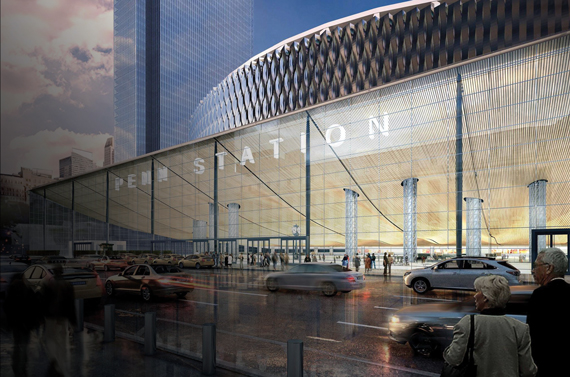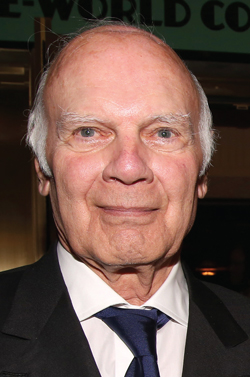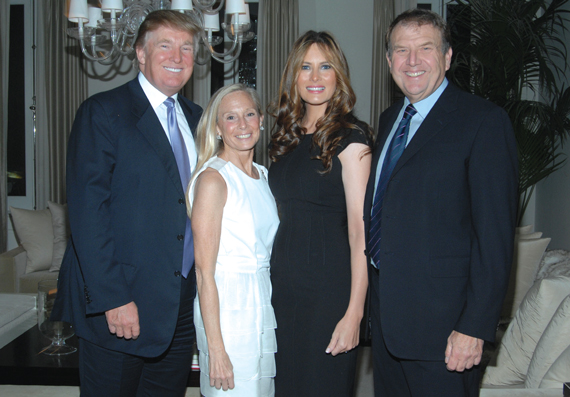Trending
New York eyes outsized share of $1 trillion prize
Trump’s tapping of developers Richard LeFrak and Steve Roth for key infrastructure posts raises hopes for windfalls and fears of conflicts

During a weekend respite at Mar-a-Lago last month, President Donald Trump turned to one of his oldest friends with a bold question about the administration’s planned 2,000-mile wall along the Mexican border. Trump reportedly asked Richard LeFrak, a prolific developer in New York and New Jersey, if he wanted to build it, and LeFrak demurred.
While estimates on the cost of the project range from $8 billion to as much as $40 billion, Trump said he believed the prices being quoted in the media seemed too high. But LeFrak told the New York Times that he felt the job might be better suited for a government agency that specializes in antiterrorism and border control. “I thought you were going to have Homeland Security deal with this,” he said regarding his conversation with the president.
Still, generally safe assumptions have been repeatedly dispelled in the era of Trump. And LeFrak is not just one of Trump’s most trusted friends. As of January, he’s also co-head of the council of experts tapped to oversee one of the administration’s priciest priorities: Building a cool $1 trillion worth of infrastructure in the U.S.
LeFrak shares that role with another long-time Trump business associate, Vornado Realty Trust founder and chief Steve Roth, whose interests have been woven together with Trump’s in a series of deals. Today those strong relationships are buoying hopes that New York could get preferred access to a vast new federal feeding trough — even as they fan fears about huge potential conflicts of interest.
While details remain sparse, the president has outlined a broad vision of his plan as well as how he intends to fund it (with tax breaks to private investors paying for the lion’s share of projects). “I’ve spent my entire life and business looking at the untapped potential in projects and in people all over the world,” Trump said in his November acceptance speech. “That is now what I want to do for our country.”
An October position paper co-authored by billionaire investor-turned-secretary of commerce nominee Wilbur Ross laid out a vision for infrastructure investment that hinges on deals, rather than politics as usual. “We don’t need more conferences and bureaucracies to fix our infrastructure,” wrote Ross and business professor Peter Navarro. “We need muscular and implementable transactions.”
More than a month into the Trump presidency, however, some say infrastructure planning has stalled and could be pushed off until at least 2018.

Steve Roth
But with $1 trillion at stake, it could be worth the wait. A New York developer in the White House, some say, gives the city a good chance of emerging a big winner. And the key roles played by LeFrak and Ross only shorten those odds.
“They understand the projects that New York needs. Will they help New York projects get funded? Look, it helps,” Carlo Scissura, president and CEO of the New York Building Congress, told The Real Deal. “Putting aside party politics, I’m focused on how we’re going to get money to rebuild New York,” he added. “This may be the only thing everyone can agree on — the roads, trains, airports, everything needs improvement.”
To help pave the way, advocates for the state’s wish list of infrastructure projects met in early February at the Midtown offices of Norton Rose Fulbright for a strategy session. In attendance were members of the Partnership for New York City, along with Rick Cotton, Gov. Andrew Cuomo’s special counsel for interagency initiatives; Polly Trottenberg, the city’s transportation commissioner; and New York State Assemblyman Robert Rodriguez.
“We’re assuming they’re going to be looking for projects that leverage private investment and create jobs and get the most bang for the buck. So we are raising the question: Is New York prepared to win in that scenario?” said Kathryn Wylde, the partnership’s president.
Thanks to the political calculus of a host of state and local lawmakers, a battery of New York projects already stand teed up and ready to fly. Most notably, that includes $100 billion worth of “shovel ready” infrastructure projects advanced by Cuomo. They range from an extension to the new Second Avenue subway line to a major revamp of the nation’s busiest rail center, Penn Station. “The governor has really done an enormous amount — and I underscore enormous — for the state and city,” said Gary LaBarbera, president of the Building and Construction Trades Council of Greater New York. “As we speak, thousands of construction workers are at work today because of his bold vision.”
With luck, and an injection of fresh funding from Washington, thousands more could end up laboring away on the vast, multipronged Gateway Project centered on Penn Station. Currently estimated to cost $14.5 billion, the project would hinge on a doubling of the capacity of trains entering and leaving Penn Station by building a new tunnel under the Hudson River. Additionally, the plan’s architects envision a revamping of the station to expand platforms and waiting areas.
Amtrak officials say the tracks between Newark and New York are the most heavily used stretch of railroad in North America, carrying 450 trains daily. But the aged tunnels under the Hudson River were damaged in Superstorm Sandy and badly need repair.
Salt left behind by the storm is eating away at the steel-reinforced concrete tunnels. Meanwhile, a 2014 analysis found that the tube’s bench walls — which house cable signals and other high-voltage conduits — are crumbling, with pieces of concrete falling onto the tracks in places. “The tunnels are 106 years old,” said John Porcari, interim executive director of Gateway Development Corp., which is overseeing the project.
To date, Amtrak has spent several hundred million dollars laying the groundwork for the project. With $235 million in Sandy-spawned funding, the company built a concrete casing — effectively an underground box — beneath Hudson Yards that preserves the right of way for trains to travel into Penn Station.
 Now officials are banking on the project coming to fruition. “We think of this as the most urgent infrastructure project in America, period,” Porcari said. Buoying hopes, the plan topped a list of 40 high-priority projects identified in a Treasury Department study this winter that concluded the projects could net up to $1.1 trillion in net economic benefits.
Now officials are banking on the project coming to fruition. “We think of this as the most urgent infrastructure project in America, period,” Porcari said. Buoying hopes, the plan topped a list of 40 high-priority projects identified in a Treasury Department study this winter that concluded the projects could net up to $1.1 trillion in net economic benefits.
But as good as Gateway could be, it also represents an early and major test for the administration’s willingness to avoid gross conflicts of interest. The fact is that one of the largest private-sector beneficiaries of Gateway could be none other than Steve Roth. Vornado has a whopping 9 million square feet of office and retail properties in the immediate vicinity that its management keenly desires to upgrade. “The goal is to achieve market rents as much as 50 percent higher,” Roth told analysts in an earnings call in February 2016.
The size of those holdings will almost raise major questions for Roth. “He could recuse himself, which is what I would do at the Port Authority,” Scott Rechler, CEO of RXR Realty and former vice chair of the Port Authority of New York and New Jersey, told TRD. “If I had a potential conflict, I’d recuse myself from voting or being part of the discussion.”
LeFrak too will likely face some difficult conflicts in coming years. Most notably, he has spent decades developing Newport, a 400-acre community in Jersey City, N.J. He has also previously questioned just how much firms like his should pay for public works that benefit their assets.
Despite the myriad potential conflicts, LeFrak and Roth undeniably have much to contribute to the infrastructure push, including the development community’s confidence that stems from the duo’s decades of experience buying and building large-scale properties. “Big infrastructure projects have a lot of similarities to large real estate projects, in the sense that you need to deal with a lot of different stakeholders,” said Rechler. “There’s big finance, construction and local players in both.”
For those reasons, Trump has repeatedly turned to trusted peers with his infrastructure questions. In December, even before he took office, the president emailed billionaire developer Jorge Pérez with a picture of a border fence attached. “Any interest in building a 2,000 mile wall — 30’ high — between U.S.A. and Mexico? Call me,” the email stated, according to the Wall Street Journal. Pérez, who called the wall “immoral,” turned Trump down. “Once it’s finished, which side of it will I be on?” he said.
Not all of the administration’s infrastructure priorities are so politically charged, of course. And private development dollars are certainly lined up and ready to go.
Globally, more than $645 billion flowed into infrastructure deals last year, according to alternative assets database firm Preqin. And that was on top of $137 billion worth of commitments yet to be put to use. “There’s no lack of capital. There just aren’t that many opportunities in the U.S.,” said David Sigman of the New York investment and development firm LCOR. “There’s plenty of private money; they’re looking for opportunities.”
But private investment comes with challenges. Investors need to see a return on their investment, and it’s hard to drive revenue without imposing user fees.

Donald Trump, Karen LeFrak, Melania Trump and Richard LeFrak
Ironically, LeFrak himself may be among the skeptics. “There is a limited amount of public infrastructure that can be extracted from the development community,” he told the Times in a 2002 article describing negotiations between Jersey City officials and his company over who should pay for a pedestrian walkway at Newport. “The last time I looked, my name wasn’t the state of New Jersey.”
When it comes to many projects, however, the benefits pencil out clearly for multiple parties. An Amtrak-commissioned study published in 2014, for example, calculated that the Gateway Project could return $4 for every dollar invested. Railroad officials also point out the project has myriad other far-reaching benefits: The New York metro area contributes 10 percent of the country’s gross domestic product, and failure of the existing Hudson River tunnels that ferry 200,000 people to and from work each day could be catastrophic. “The busiest part of the Northeast Corridor is only two tracks,” Porcari said. If disrupted for any reason, he added, “it’s a single point of failure for 10 percent of America’s GDP.”
In making their recommendations on the country’s infrastructure spending, LeFrak and Roth have another key tool in their arsenal, on top of their experience as developers: the confidence of their boss in Washington, D.C.
“We met when we were kids starting out in the business,” LeFrak told TRD in April 2016. Meanwhile, Roth and Trump have crossed paths over the course of their long careers. For openers, they both built their businesses in part by turning around distressed properties in the 1970s. Years later, in 1998, Trump outbid Roth to buy the GM building for $878 million. Even today, Vornado manages Trump’s 30 percent stake in 1290 Sixth Avenue.
No wonder LeFrak and Roth received Trump’s unequivocal endorsement in January when he installed them as advisors to his infrastructure plan. “They’re pros,” Trump told the Journal at the time. “All their lives, they build. They build under-budget, ahead of schedule.”
When it comes to funding their operations, however, the two men beg to differ. The LeFrak family has little or no debt on its holdings, some 40 million square feet of property in New York, Los Angeles, London and Miami. Newport in Jersey City, for example, is being built without loans.
As a REIT, Vornado has taken a very different tack. “Roth started out using tax credits. He was the master of that,” said Robert Shapiro, president of City Center Real Estate, who is best known for negotiating the buying and selling of air rights.
LeFrak and Roth also have differed at times on the value of public infrastructure.
In Jersey City, the Hudson Bergen Light Rail surface transit line bisects LeFrak’s Newport development. “It is really a very important part of the continued success of Newport,” said Martin Robins, a transportation consultant who negotiated with the family to build tracks on their property in the 1990s. “They were conscious of the role of infrastructure and how it facilitates economic development,” he said. “But they were also sticklers. They wanted the system to be built in a certain way.”
For Roth, the situation is more complicated: His fortune — and Vornado’s — is directly linked to pending improvements to Penn Station. The REIT’s “Big Kahuna” is the repositioning of its Penn Plaza portfolio, Roth said last year, and the company is investing hundreds of millions of dollars into the area around Penn Station, including the redevelopment of the Farley Post Office with partner Related Cos.
“Roth knows very much how important Penn Station is and how many people go through there and the challenges if things aren’t flowing properly,” said analyst Alexander Goldfarb of Sandler O’Neill. “There’s a lot of pent-up hope that now a lot of things can finally happen.”
Much remains to be seen. Two months after the administration took office, its plans remain vague at best.
“There’s no there in there yet,” said one source on the condition of anonymity, speculating as to who is calling the shots.
LeFrak declined to comment for this article, and representatives for Vornado did not respond to repeated requests for comment. But developer Bill Rudin, who chairs the Association for a Better New York, speculated that LeFrak and Roth would take a “top down” look at how to maximize dollars. “That’s agnostic of what projects they will focus on,” he said. “Once you get past that, then what are the projects?” Rudin speculated that the council would comprise a broad cross-section of academics, finance types, architects and engineers.
During a mid-February earnings call, Roth downplayed how much time he would likely commit to Trump’s infrastructure council. “My role at Vornado is my day job, it’s my night job, it’s my passion,” he said. Though he said he was “honored” to be involved, he stressed his advisory role. “I’m not a line executive. I’m not in any way an employee of the government.”
But infrastructure advocates and others say these two advisors have clout that could produce big results. “New York certainly has a friend in the administration. I’m sure Roth has Trump’s new cell phone,” said Goldfarb.
“Look, I think they understand that their role is a national role, that infrastructure is important all over the country,” cautioned Rudin. So I think they can’t take on this responsibility and look at it parochially, but I think they understand a dollar spent on infrastructure here has a tremendous impact — not just for New York.”
Going forward, LeFrak and Roth will have to work with key administration personnel as well as outside stakeholders helping to shape the national infrastructure discussion.
Among them is Martin Whitmer, a lobbyist representing the American Association of Railroads, National Asphalt and Utilities, who headed Trump’s transportation transition team. And then there’s Richard Bagger — a New Jersey pharmaceutical executive and former aide to Gov. Chris Christie — who helped manage the transition team before being ousted in November. Bagger is now chairman of the Gateway Development Corp., which is lining up the funding for the tunnel project.
In recent weeks, key decision-makers have stepped into new roles: Elaine Chao — a labor secretary under George W. Bush and the wife of Senate Majority Leader Mitch McConnell — was confirmed as transportation secretary in January. More recently, CJ Gribbon, who served in the Bush administration and later worked for asset manager Macquarie, was tapped to lead the public-private partnership office.
“We don’t know to what extent they’ll divide the pot” of infrastructure dollars, said Kenneth Fisher, a former New York City councilman and a member of Cozen O’Connor’s real estate practice. “He has an edifice complex,” the attorney said of Trump. “He likes to build big things.”




